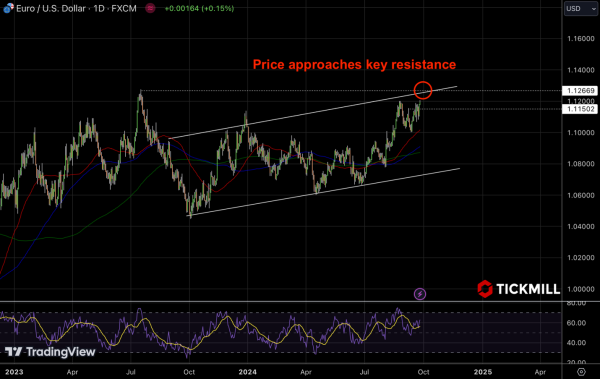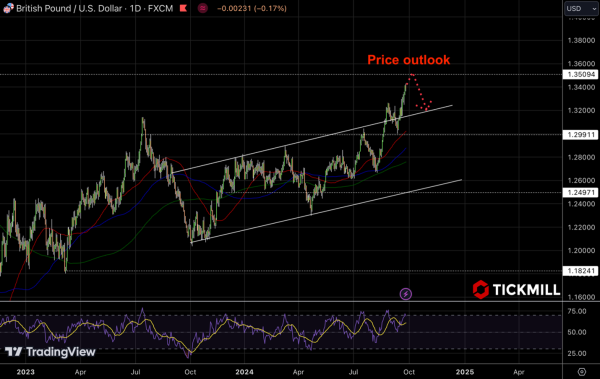EUR/USD Surge Nears Yearly High as Market Optimism Rises
The latest surge in the EUR/USD pair, which has pushed it close to its yearly high of 1.12, highlights the complex interplay of global economic factors. The key catalyst for this upward movement is the renewed optimism in the market following China's announcement of extensive stimulus measures aimed at mitigating the economic slowdown. This optimism has softened demand for the US Dollar, which typically thrives in times of uncertainty, thereby providing a boost to its main peers, including the euro.
China's stimulus measures are designed to combat the growing risks of economic deceleration, and their implications are far-reaching. By injecting liquidity into the economy, the Chinese government aims to bolster domestic consumption and stabilize the financial system. This move has reverberated across global markets, increasing investors' risk appetite and shifting capital flows away from the safety of the US dollar.
Despite these tailwinds, the euro's ascent is not without challenges. Recent data has painted a gloomy picture for the Eurozone, with the Flash HCOB Composite PMI falling to 48.9 in September—its lowest level since January. This contraction, driven primarily by a prolonged downturn in the manufacturing sector, raises concerns about the sustainability of the euro’s current strength. The German manufacturing PMI, a key indicator of economic health in the region, has remained in contraction territory for over two years, coming in at a dismal 40.3. This persistent weakness could eventually weigh on the euro if economic activity continues to stagnate or worsen.
From the technical perspective, EURUSD is currently approaching a key resistance level near 1.1267, as shown in the chart. This level aligns with the upper boundary of a rising channel, indicating a potential area where the pair could face selling pressure. The recent rally has been driven by weakening US dollar sentiment, partly due to market speculation about future rate cuts by the Fed. However, with Eurozone economic data still underperforming, a rejection from this resistance could trigger a pullback, possibly towards the 1.1150 level. If bearish momentum increases, the price could test the lower channel support around 1.1000, especially if upcoming US economic data surprises to the upside, strengthening the dollar:

Recent movements in US interest rate derivatives suggest growing market expectations for the Federal Reserve to cut interest rates by 50 basis points to a range of 4.25%-4.50%. The chance of this outcome has jumped from 35% a week ago to 60%. This sentiment is driven by concerns over a slowing labor market, as evidenced by the Fed’s decision to initiate a rate-cutting cycle earlier this month. If these expectations materialize, they would mark a significant shift in the Fed's policy stance, potentially leading to further depreciation of the US dollar.
Upcoming US economic data, particularly the core PCE Price Index and Durable Goods Orders, will be crucial in shaping market expectations. A higher-than-expected core PCE could temper rate cut expectations, providing temporary support for the Dollar. Conversely, weaker Durable Goods Orders would reinforce the narrative of a slowing economy, adding pressure on the Fed to continue easing monetary policy.
Meanwhile, the British Pound has struggled to maintain its footing against the US dollar, retreating sharply from the 1.3400 resistance level. BoE Governor Andrew Bailey’s recent remarks suggest a gradual downward trajectory for interest rates, as inflation appears to be stabilizing around the bank’s 2% target. However, persistent inflation in the services sector, with the Service CPI rising to 5.6% in August, remains a key concern. This could complicate the BoE’s policy decisions and keep the Pound under pressure in the near term.
Talking about the technical side of GBP/USD, the price targets a critical resistance level around 1.3510, as indicated in the chart. This resistance coincides with the upper boundary of a rising channel, suggesting a potential pullback scenario. The recent bullish momentum, fueled by the weakening US dollar and optimistic market sentiment, may face exhaustion at this key level. If the price fails to break above this resistance, a retracement towards the channel's midline around 1.3200 could be expected. Further downside momentum might lead to a test of the support at 1.2990, especially if the upcoming US economic data bolsters the dollar or if the Bank of England's dovish stance continues to weigh on the pound:
